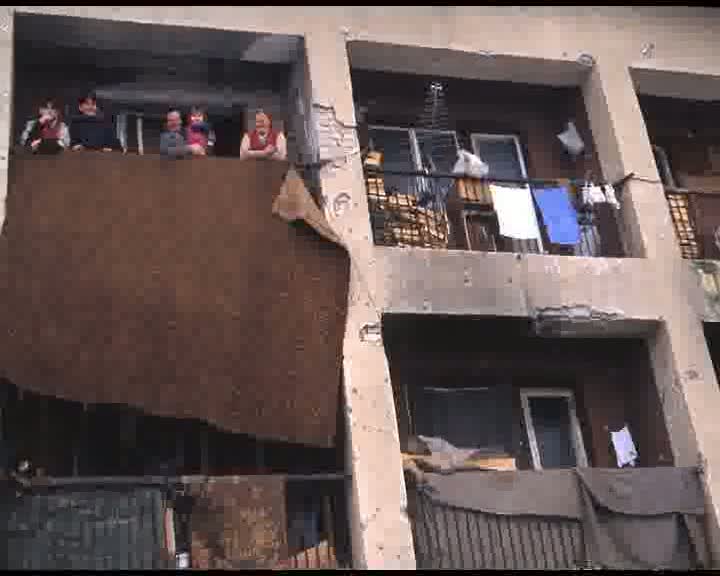A new home on memory lane in Bosnia and Herzegovina
News Stories, 14 April 2011
GORAZDE, Bosnia and Herzegovina, April 14 (UNHCR) – Biserka Vukasinovic has a strong homing instinct, honed from her experience as a refugee twice over, a returnee and an internally displaced person. Every time she lost her home, she found a way back.
The first time she was displaced from her native Bosnia and Herzegovina was during the Second World War, when she was a young girl. "My father and mother prepared an ox-drawn cart and loaded our belongings. With my two sisters, we fled. We found a house without windows and doors, and sought shelter within," she recalls with clarity. "Once, a German soldier came to our door, held me on his knees and began to cry. I reminded him of the daughter he left behind in Germany."
They returned home eventually. Biserka grew up, married and lived with her husband of some 30 years, Aco Vukasinovic, in Gorazde, a city in the eastern part of the country. He passed away shortly before the 1991 conflict, and when war erupted, she became one of 24,000 Bosnians to seek refuge in Serbia.
Biserka fled with a severe case of pneumonia and financial difficulties. "The local Red Cross did not recognize me as a person in need of assistance," she remembers. "I had to find a variety of ways to survive. Many times I went to Romania, Hungary and Bulgaria, where I purchased the goods which I resold in Serbia."
The conflict ended in 1995, and she dreamed of returning to Gorazde to rebuild her damaged home. While in Serbia, she tried unsuccessfully to collect donations for the reconstruction. Eventually, her nostalgia compelled her to voluntarily renounce her refugee status in Serbia and return to Gorazde in 2009. Standing among the ruins of what was once her home, "I was struck when I saw that only walls remained," she recalls.
With help from UNHCR's implementing partner Vasa Prava, Biserka applied for internally displaced person (IDP) status, becoming one of 113,000 IDPs living in Bosnia and Herzegovina since 2006. The municipal authorities allocated accommodation in some barracks in Gorazde, but Biserka's long-time friend Jovanaka, a returnee herself, welcomed Biserka into her home.
Biserka was selected for UNHCR's housing project, which seeks to rebuild homes for vulnerable people such as single mothers, large families with small children and the elderly, and families with socio-economic difficulties. A total of 22 most vulnerable families numbering 80 people were selected to receive assistance for sustainable return to pre-war areas of residence, including support in acquisition of rights to social protection, health care, pension and education.
At the end of last year, Biserka moved into her new home on her old patch of land. With her modest pension, she couldn't furnish it the way she wanted. Nonetheless, the two beds, a table and stove were satisfactory.
For her, the fact of homecoming was more important, as it was for over 1 million other returnees who have reclaimed their homes since 1995. As a group, they represent a return statistic. As individuals, they represent courage. With modest to no support, Bosnia's returnees reclaimed their lives and place of origin, even though in many cases return was unwelcome, and economically or socially strenuous.
Biserka is an example of audacious returnee women who provide a network for one another, without which she herself could not have returned. She offers the same support in return. Most recently, she hosted a gathering in her home where some 15 returnee women drank coffee, joked and made handicrafts while inviting collective laughter into what became again Biserka's home.
While these women seem to be settling in well, thousands of internally displaced individuals and families throughout Bosnia and Herzegovina still have immense needs, 16 years after the conflict ended. The most vulnerable among them need housing, psycho-social support and income-generating projects.
A little help goes a long way, as Biserka can attest. Today, at 73, she is sociable and full of optimism. "I really feel happy to be able to move to my humble home and to host gatherings for a large number of women and alleviate their feelings of neglect and abandonment," she says with a smile.
Biserka and Aco had no children and, although he is dead, she maintains a special bond with her late husband, visiting his grave daily. Some two kilometres from her home she has a garden where she planted ornamental trees, roses and other flowers. This spring, she will begin to cultivate land, adding vegetables to her plot.
On the table of her home is an old photo taken in the 1960s in which Biserka and her husband hug one another, smiling in their youth. She holds an album with photographs of him, family and friends. She says she is happy that these memories remain with her, memories that now give her the strength to live in peace, with dignity.
By Nefisa Medosevic and Mina Jasarevic in Goradze, Bosnia and Herzegovina




































